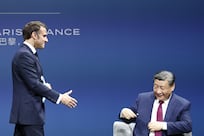There are billions of smartphones in the world, which means there are billions of smartphone cameras, which means that it’s highly likely that, whether you know it or not, someone is taking your photograph right this minute.
And the answer to your next question is, yes, you probably look fatter in the photo than you imagined.
Take a walk through any picturesque setting or tourist magnet and marvel at the throngs of people taking selfies. What’s odder, most of these people are standing with their backs turned, looking away from whatever monument or mountain or painting they travelled a long way to see, to get themselves and the object into the same frame.
It goes like this: you fly to France, check into a hotel, get up early the next morning, stop at a cafe for a quick coffee and a croissant, head over to the Louvre and stand in a winding queue, struggle your way into the museum itself, dodge schoolchildren on class trips and wandering tourists through the seemingly endless galleries, finally arrive where they're keeping the Mona Lisa, push and shove and wiggle your way to the front of the crowd that's gathered in front of the most famous painting in the world, and when you finally – finally! – get to the front and have a clear and unobstructed view of Leonardo da Vinci's masterpiece, you immediately turn your back to it.
In order, of course, to take a selfie.
And then you find a bench somewhere and sit with everyone else who has taken a selfie, and spend the next 30 minutes filtering and touching up the image to make yourself look more attractive, thinner, richer and happier.
But there aren’t many truly “oneself only” selfies. There are always strangers and others somewhere in the background or around the edges of the frame. These interlopers can be cropped out – pretty much every photo app offers a range of editing and cropping functions — but often they’re just left there, looking less attractive, fatter, poorer and more miserable than whoever is occupying the centre of the frame.
It’s a bit disconcerting to remember that the law of averages — billions of mobile phones, billions of cameras, billions of selfies — means that we’re all in someone else’s snapshots looking not our best.
We’re all victims of candid photography, the way movie stars and international socialites are the victims of paparazzi, who always seem to capture famously attractive people looking bedraggled and puffy and harried and like they need to take a bath.
Celebrities have solved this problem in their professional lives, in the way they solve most business-related problems: with a contractual agreement. On every movie production or television show, the players have something called “photo approval”, which means that any photographic image published or reproduced by the studio or network must first be submitted to them for approval.
If you’re a lower-level actor, the contract usually stipulates a limit to the number of times you can disapprove a photograph, but major stars have an unlimited number of “destroy that image” chips they can play. After all, there’s no way to squash an unflattering paparazzi snap, but that doesn’t mean you shouldn’t take control of all of the others.
It’s axiomatic, naturally, that the cooler the star, the least uptight he or she is about photo approval. I’m told that actors such as Jack Nicholson and Brad Pitt are pretty lackadaisical about which photos are released and which aren’t. And I’ve seen younger stars like Jake Gyllenhaal and Jennifer Aniston out and about, and I’d bet a lot of money that you couldn’t take a bad picture of either of them, even if you woke them up at three in the morning. But I’ve also heard that a certain multi-Oscar-winning actress has her regulations codified to, simply: no images from the right side of her face and no images from anything less than 25 degrees above eye-level. (We all look better, younger and thinner looking slightly upwards.)
The next president of the United States, Donald Trump – and trust me, it’s as impossible to type those words as it is to accept that it’s really happening – was a television star for years (and still is, if you really think about it), and he’s clearly used to having photo approval.
Last month, Mr Trump complained bitterly that the coverage he had received in The New York Times had been uniformly negative and biased – and as proof he pointed out that the paper regularly uses photographs of him that feature his double-chin and slightly jowly look. A few days ago, he tweeted out his photo disapproval of an image being used by the CNN network, despite – according to the photographer – having approved it during the photo shoot. All of which suggests what we already knew: Donald Trump may be a star, but he's not cool.
Rob Long is a writer and producer in Hollywood
On Twitter: @rcbl





